| Please access the following URL if you want to secure using SSL. All pages in the site will be secure pages. |
| https://secure02.blue.shared-server.net/www.fish-food.co.jp/message english 1.2021.html |
Welcome to FISH FOOD TIMES
Jan. 2021 issue No.205

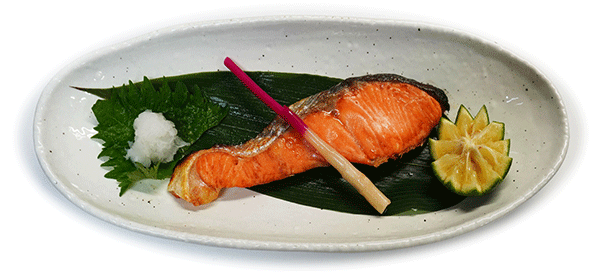
1 slice salmon in 2 days
COVID-19
In 2020, the world was in great turmoil with COVID-19, but what will happen this year? We hope that the pandemic will gradually come to an end with the start of vaccination in some countries in December, but it is difficult to predict the situation in the world in the future. As of December 25, more than 80 million people worldwide have been infected with the new coronavirus, and more than 200,000 have been infected in Japan. As you can see in the graph below, Japan is still a minor injury when compared to the West.
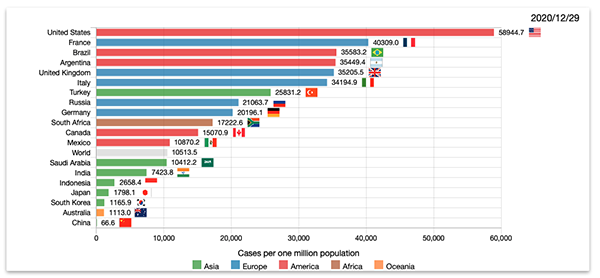
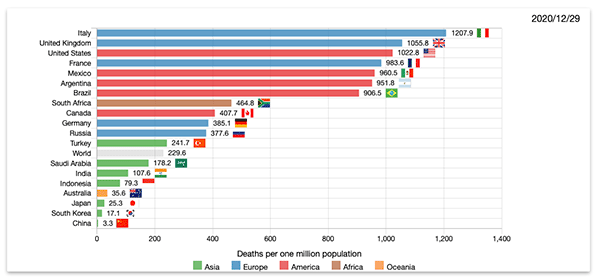

However, as you know, even in Japan, the momentum of the third wave has not stopped since November, and it is unpredictable what will happen in the future, but it seems that it is not necessary to mention it in detail here. .. It's more important that you don't become one of the infected people, and how do you do that? In this month's issue of FISH FOOD TIMES, I would like to mention "increasing immunity by eating fish" as a position to handle fish.
Immunity
Behavioral patterns such as wearing a mask, washing hands, and securing physical distance have become a daily sight in Japan. This is a method of repelling the invasion of the virus by physically and spatially blocking it, and it is not effective for the purpose of having strong immunity that is not defeated by the virus as a human being, and in some cases, it has the opposite effect.
One of them is hand-washing disinfection. To avoid misunderstandings from readers, I am now obliged to wash and disinfect my hands as etiquette everywhere I go in my daily life, and I also wear masks. I'm not against the movements of the world. However, even if that is all right at the moment of the emergency situation in which the world is suffering from the new coronavirus, if such a thing is required even in the "normal time of after corona" that will come in the future, I think this has to be questioned from the perspective of human immunity.
Last year's FISH FOOD TIMES No.197 May 2020 issue also mentioned a little about human immunity, and at that time Koichiro Fujita, Professor Emeritus of Tokyo Medical and Dental University, wrote "Human life is 90% of the intestine" and " The contents of the book "the habit of damaging and training the intestines" were summarized in my own way and introduced as follows.
In order to remind you of what immunity is, I dare to paste the same content below.
The intestine has three major functions: digestion, immunity, and detoxification. The intestine is the largest immune system in the human body, food is absorbed from the small intestine, and even if pathogenic bacteria enter the body, it can be prevented if it is not absorbed from the small intestine. The small intestine is the immune system called the largest fortress in the human body. Supporting the immune system is an intestinal bacterium called a symbiotic bacterium that lives in the 20,000 kinds of 1,000 trillion intestines. The intestine is responsible for 70% of the immune function, but if immune functions are distinguished, they can be divided into infection defense, health maintenance, and aging prevention. Whether you get a cold or flu depends on the strength of your immunity, so if your intestines are healthy, you can prevent infection with the virus, and if your function is weak, you will catch a cold. The bactericidal act that the Japanese are working on every day is an act that damages the intestinal bacteria that coexist in the intestines and weakens the immunity. The number of adults with measles, norovirus, or rotavirus, once said to be a disease of children with weak immune system, is due to abuse of fungicides and antibacterial agents. Immunity is strengthened and strengthened each time it fights a nearby pathogen. Simply eliminating the bacteria only weakens the immune system by losing the opportunity to train it. Escherichia coli is a symbiotic bacterium that lives in the intestine and is indispensable for human life. It is like a sentinel that works to get rid of pathogenic bacteria when they enter the body, and it also works to synthesize vitamins while breaking down indigestible dietary fiber to feed itself. Humans take a wide variety of bacteria into their intestines during the first year of life, and the richness of the intestinal flora determines the core of their health status throughout their lives. A baby can develop immunity by crawling and licking the hands of the fungus on the floor. A variety of indigenous bacteria that feed on the skin's fat are inhabited on the skin, and when the indigenous bacteria eat fat, a fatty acid film is created, which creates a weakly acidic barrier on the skin and prevents pathogenic bacteria from attaching. However, if you wash your hands with soap, about 90% of the bacteria that are indigenous to the skin will disappear, and a medicated mouthwash will drastically reduce the bacteria that protect your throat health. Viruses and bacteria that cause infectious diseases are more likely to adhere to the hands and throat that are free of indigenous bacteria and oral bacteria. The stratum corneum of the skin is the uppermost layer of the skin and is the hardest part of the skin that functions to prevent invasion of external enemies. The cells of the stratum corneum are dissociated when the sebaceous membrane is lost, and pathogens and allergens are easily invaded. When a foreign substance enters through a gap in the skin, the immune system reacts, causing inflammation such as itch and eczema. If you use drugs regularly to keep away bacteria, your immune system will be sluggish and your immune system will be weakened. |
Not only is bonito rich in protein, it is also rich in vitamins D, B6, B12 and niacin, as well as the well-known DHA and EPA. Therefore, for the purpose of strengthening human immunity, we eat nutritious fish such as bonito as a staple food, and eat miso soup, natto, and vegetables rich in dietary fiber as side dishes in a well-balanced manner recommended by Professor Fujita. It was stated in issue 197 that it was important.
However, I didn't mention the immunity of fish in more depth, so I would like to write more about the nutrition and immunity of fish in this month's issue.
Vitamin D to boost immunity
Viruses can be repelled by increasing the number of killer T cells, and this power is called immunity. The human body is made up of 60% to 70% of water and about 20% of protein, and foods that boost immunity require protein to promote cell metabolism. There are animal protein and vegetable protein in the protein, and the animal protein contains essential amino acids in a well-balanced manner than the vegetable protein. Essential amino acids are amino acids that make up proteins and must be ingested as nutrients because the body cannot synthesize a sufficient amount. Animal proteins that contain a large amount of essential amino acids in a well-balanced manner Ingestion is more effective in boosting immunity.
Methods for boosting a person's immunity include moderate exercise, sufficient sleep time, and a well-balanced diet. And in Japan today, in order to protect yourself from the new coronavirus, hand washing and disinfection, wearing a mask, keeping a distance from people, etc. are performed, but what else can you do in your daily life? .. As one of them, I think it is important to take in nutrients that boost immunity and build a strong body that is not infected by viruses.
Magnesium, zinc, and vitamin D are three typical nutrients that enhance immunity.
First, when magnesium is deficient, it tends to cause heart problems. Magnesium also has the function of suppressing the rise in blood sugar level, and people with low blood magnesium levels are more likely to develop myocardial infarction and angina. And if magnesium deficiency continues for a long time, it is easy to get diabetes.
Foods high in magnesium are rich in dark green vegetables such as spinach, broccoli and bitter melon, and are also abundant in seaweeds such as hijiki, dried seaweed, kelp and wakame seaweed. Since these also serve as food for intestinal bacteria, they are convenient in terms of activating intestinal bacteria.
Next, zinc plays a central role in hundreds of enzymes, and is involved in various enzymes such as proteins, lactic acid, and alcohol, and metabolizes them. Among them, zinc has an important function of preventing rust that protects the body from oxidation and excreting harmful metals from the body. When a large amount of zinc is consumed and the zinc blood concentration rises, the number of lymphocyte killer T cells that enhance immunity increases.
Foods high in zinc have oysters as a special existence. Zinc is also abundant in liver and cheese, but it is also one of the essential trace elements that are gradually and widely present in many foods such as meat, seafood, and vegetables.
By the way, the last third is Vitamin D, which will be taken up as the leading role in this month's issue.
The basic function of vitamin D is to help the absorption of calcium from the intestines. Vitamin D is a fat-soluble vitamin that not only promotes the absorption of calcium from the intestine to maintain strong bones, but also promotes muscle protein synthesis.
Vitamin D is a very important ingredient that works throughout the body. The tissue of the skin contains a large amount of a substance called provitamin D (7-dehydrocholesterol), which is the source of vitamin D, and humans are exposed to ultraviolet rays (UV) on the skin to synthesize vitamin D from the body's provitamin D. Vitamin D synthesized in the skin is carried to the liver by a protein (vitamin D-binding protein) and processed by the liver to become active vitamin D.
In Japan, it has been important not to be deficient in vitamin D, but it has been found that even a slight deficiency increases the risk of various diseases other than bone. Today's Japanese are declining in their intake of fish, the source of vitamin D. Not only that, the habit of UV care for women to prevent sunburn has become widespread, causing the phenomenon of vitamin D deficiency in Japan.
Vitamin D also has immunostimulatory, antiviral, and antiinflammatory effects, and a deficiency increases the risk of acute viral respiratory infections and pneumonia, and increases the relationship with viral morbidity, mortality, and severity. .. In addition, since receptors that receive vitamin D are present in many immune cells such as T cells and B cells, it is considered that vitamin D sufficiency is important for maintaining immune function. Vitamin D has been confirmed to have various immune-related functions, such as causing macrophages responsible for innate immunity to produce antibacterial substances and preventing lung inflammation and damage caused by viral infection.
However, in this FISH FOOD TIMES, I will not enter any further specialized and medical part, including the relationship between vitamin D and the new coronavirus, because I am an outsider.
Vitamin D intake
There are six types of vitamin D, from D2 to D7, and what is important for humans is plant-derived D2 and animal-derived D3. D2 contained in shiitake mushrooms is not as much as D3 contained in fish, and D3 is an active vitamin with higher bioactivity thanD2.
How much vitamin D should a person take per day? The Ministry of Health, Labor and Welfare has raised the recommended daily intake of vitamin D for people aged 18 and over from 5.5 µg to 8.5 µg in the 2020 edition of "Japanese Dietary Intake Standards."
On the other hand, in the United States and Canada, the recommended amount of vitamin D specified in the dietary intake standard is "15 µg per day for those aged 70 and under, and 20 µg for those aged 71 and over", which is quite different from the recommended intake in Japan. This seems to be related to the fact that the United States and Canada do not consider producing vitamin D in the skin by sunlight.
The table below shows the vitamin D content of fish posted on the website of Nishisaitama Chuo Hospital. The unit µg is microgram, which is equivalent to one millionth of a gram. Micro is also displayed in units of IU, 1 µg is 400 IU, and blood vitamin D concentration is displayed in ng (nanogram) units, which is ng / ml.
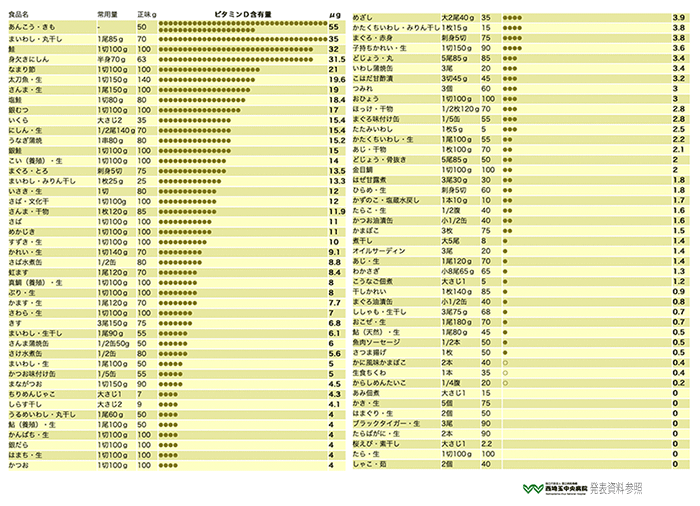
Most fish contain vitamin D, and eating 100g of fish fillet will give you more than half of the vitamin D you need per day. However, shrimp, crab, squid, octopus, and shellfish do not contain vitamin D. Also, beef, pork, chicken, and their internal organs, and milk, dairy products. Furthermore, vitamin D is almost absent in vegetables, potatoes, legumes, fruits and seaweeds.
In this table, it is considered that no one eats the liver of anglerfish, which ranks first, on a daily basis, and it is not a common food. In addition, I don't think that the second-ranked sardine eats a whole dried sardine weighing 85g on a daily basis. And in third place is salmon, which is very common to Japanese people and is a delicious and popular fish. The content of vitamin D is as high as 35 µg per 100 g, which is not only high in content but also high in protein and low in fat.
The 100g salmon fillet illustrated in this table is rather a thick slice, and if you eat salmon at breakfast or lunch in your daily life, it is generally around 70g. It will be a typical size. If you eat 70g of salmon fillet, you can get vitamin D by about 24.5µg. According to the "Japanese Dietary Intake Standards" released by the Ministry of Health, Labor and Welfare, the recommended daily intake of vitamin D for people aged 18 and over is 8.5 µg, so one slice salmon in 2 days for people living normally. If you eat, it will be 12.25g, and vitamin D deficiency can be avoided. However, if you find it difficult to continue eating 1 slice salmon in 2 days, if you eat at least twice a week, it will be calculated to be about 10 µg per day, so the recommended daily intake of vitamin D for those over 18 years old. 8.5 µg or more can be secured.
In other words, what I would like to convey from what I have written so far is that vitamin D is beneficial as a method of boosting human immunity, and eating fish is particularly effective as a specific method. In particular, salmon is effective not only in terms of vitamin D content but also in terms of its deliciousness and popularity, so if possible, "let's eat 1 slice salmon in 2 days".
Vitamin D and health
I wrote "let's eat 1 slice salmon in 2 days", but in fact, I have been eating like this for many years in my actual family life. The breakfast pattern at home is to grill salmon with salt for breakfast about once every two days.

Of course, it's my breakfast, so like the silver salmon grilled with salt in the image above, it doesn't come with hajikami, kabosu, grated radish, a leaf of kumasasa, etc., but it's just placed on an ordinary plate, but I'm eating freshly baked salmon on the grill just before breakfast. The type of salmon seems to change depending on the mood and circumstances of my wife, and I randomly taste various types of salmon such as sockeye salmon, coho salmon, and autumn salmon.
I can't skip breakfast unless there are very special circumstances, and if I get on a plane at 7 o'clock, I have breakfast around 5:30 in the morning. In that case, my wife wakes up around 4:30 in the morning, prepares the same breakfast as usual, such as grilled salmon and miso soup, and then drives me to the airport.
Perhaps because I have been eating like this for a long time, I never take care of the hospital because of a cold. I think I went to the internal medicine department because of a cold most recently, but I don't remember clearly. In other words, it seems that the author inadvertently eats salmon high in vitamin D3 frequently, resulting in an age-immunized body, free from the new coronavirus, and maintaining one's health. The author's daily diet may be an example of the effectiveness of vitamin D3.
The author believes that the phrase "medicine and food are the same source" is the truth. The author, who will be 72 years old in 2021, wants to continue working as usual this year. This is because I still have the physical strength to be able to stand and work with a kitchen knife for 3 to 4 hours in a row in the fresh fish department, so I am confident that I am still okay. I think that the reason for that confidence is that my wife, who has been with me for more than 40 years, keeps me eating homemade food.
My wife's homemade food is truly a genuine handmade food, and convenient processed foods such as cup ramen, chilled foods, and frozen fried foods that are probably always available in ordinary households. There is no stock of chilled foods, and they never line up on the table even once a year. A long time ago, when my son and daughter were still young, my wife rejected their wishes even though my son and daughter offered to eat cup ramen once in a while.
Since such homemade food is the norm in the home environment, the whole family, including the 93-year-old mother, has nothing to do with internal medicine-related illnesses. If I've been eating processed foods full of additives for a long time, I'm wondering if I've maintained a healthy body like I do now. Perhaps I had some kind of cancer, and it might have been difficult for me to do standing work that required physical strength.
Fish suitable for vitaminD3 intake
I've turned a little sideways, so I'd like to put it back. What I want to appeal to in this month's issue is "Let's eat fish and take vitamin D3 to build a strong and immune system." It is unclear how much immunity Vitamin D3 exerts against the new coronavirus. However, I think it is important to take self-defense measures so that they do not become seriously ill or die.
If "eating fish" could be of any help as one of the measures, it wouldn't be wasted. Below are some fish dishes that have a relatively high amount of vitamin D3 among fish and can be eaten without overdoing it in daily life.
The first is dried sardines, which is ranked second in the above ranking table.
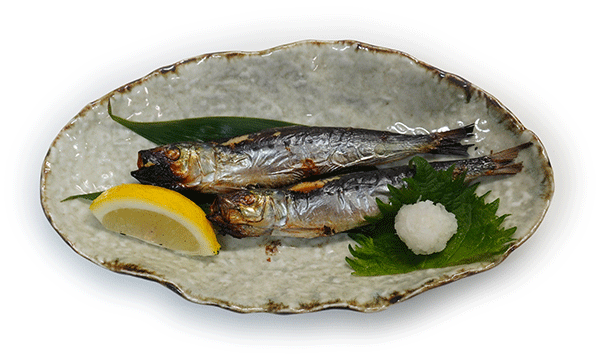
The size of this dried sardine is about 20g at most, and the total of two fish is about 40g, so it seems that vitamin D3 is about 18µg. This is 9 µg per fish, which is almost the same as the recommended daily vitamin D amount of 8.5 µg for Japanese people set by the Ministry of Health, Labor and Welfare, so one sardine dried fish about 20 g per day. If you eat it, you will clear the required amount.
The amount of sardines, which are the main raw material for dried sardines, is increasing year by year in Japan. Taking Hokkaido as an example, the transaction price is decreasing as the amount of landed sardines increases. Last year, the amount of landed sardines exceeded 200,000 tons, and this year the price is stable at a low level with a momentum approaching 250,000 tons, so it is an interesting fish to sell as a fish suitable for vitamin D3 intake.
For the same reason, chirimen (dried young sardines) is also interesting.
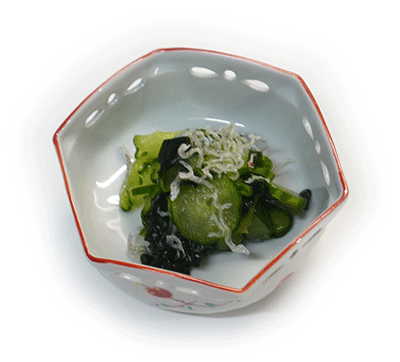
This is because the raw material for chirimen is sardine fry. Sardines are not necessarily sardines because there are also fry such as anchovy and etrumeus sadina, but at least the number of fry of sardines is increasing, and the raw materials are definitely abundant.
Chirimen is a cooking ingredient that can be easily used with vinegared cucumber and wakame seaweed. Although the size is completely different, dried sardines and chirimen are parents and children, so they are basically the same fish. According to the list above, the content of vitamin D3 is 4.3 µg in the amount of 7 g per spoon, so it can be calculated to be about 13 µg, which is three times the amount of 20 g, which is the same as dried sardines. If chirimen has 13 µg of vitamin D3, its content is higher than the same amount of 9 µg of dried sardines, and if you eat two spoons of chirimen a day for dishes such as vinegar, you will have enough vitamin D3.
Finally, let's take up mackerel, which is one of the most popular fish species in Japan as well as salmon.
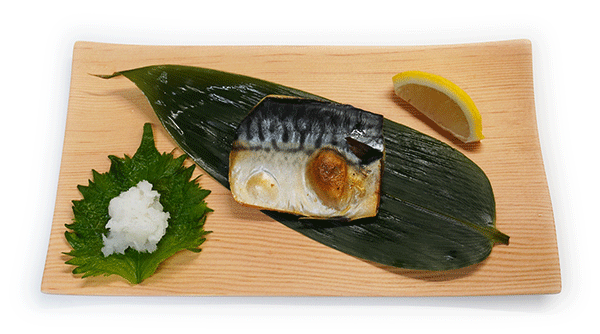
The mackerel ranked 20th in the above table is 100g per slice and has a vitamin D3 content of 11µg. For example, a half-body size of small mackerel may weigh more than 100g, but a fillet of salted mackerel may weigh about 80g. If one slice of 80g of salted mackerel is served for breakfast, you will have 8.8µg of vitamin D3 . Strangely, this figure is almost perfect for the daily intake of 8.5 µg of vitamin D for people aged 18 and over, which is in the Ministry of Health, Labor and Welfare's "Japanese Dietary Intake Standards" raised from the 2020 edition.
In other words, if you eat a slice of grilled salted mackerel fillet as shown in the image above at breakfast every day, you will have enough vitamin D intake. However, if the same mackerel continues every day, no matter how delicious it is, there is no doubt that it will be damaged and cannot be continued, so if you can continue to eat fish every day while changing with salted salmon, dried sardines, chirimen, etc., vitamin D per day It is possible to get the required intake.
Mackerel has the highest content of omega-3 fatty acids such as DHA and EPA as well as vitamin D among fish, and this omega-3 fatty acid is also effective in boosting immunity, but this time I won't mention it.
Boost your immunity and overcome the corona epidemic
By the way, I would like to summarize this month's issue as well. The January issue of the year is a little different from the know-how version of the normal month, which focuses on images, and I am daring to edit it with a focus on ideological ideas, knowing that the content is difficult. In this month's issue, I decided to mention the nutrition of fish, which is not usually noticed, based on the situation of last year's corona epidemic.
The contents described so far are basically only knowledge that gathers various information. Because I am neither a medical expert nor a nutritionist. Therefore, I would like to leave it to the reader's judgment as to how credible this description is. However, in the face of the end of the global turmoil caused by the new coronavirus, we must somehow defend ourselves. If vitamin D3, which is one of the nutrients of fish, may be effective in boosting human immunity as one of the methods, I think that there is no way not to utilize it.
Fisheries officials who are sweating at supermarket retail sites may be busy with the expansion of sales of nesting demand, and sales may be going well without any special sales promotion. However, I don't think it's just a matter of increasing sales. After all, based on the sense of mission to protect the health of our customers by expanding the sales of fish, I would like you to firmly sell various fish that enhance immunity.
We hope that our customers will hear the voice that "I didn't get the new coronavirus because I continued to eat fish", and I really want them to burn their "mission as an essential worker".
| Please access the following URL if you want to secure using SSL. All pages in the site will be secure pages. |
| https://secure02.blue.shared-server.net/www.fish-food.co.jp/message english 1.2021.html |
An opinion and the communication are to iinfo@fish food times
Date of updating 1 Jan. 2021
